Shevlin Sebastian's Blog, page 39
July 8, 2019
Tense and ease up
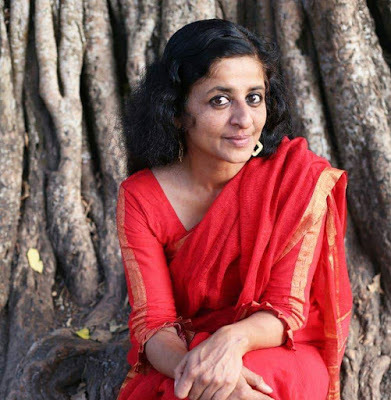
A workshop called ‘Unleash-release-ease’ will allow women to release their stress
Photo: Radha Gomati
Shevlin Sebastian
On a recent evening, artist Radha Gomati along with her friends Shaji Appukuttan, and web designer Thomas Augusti of Sparcs Studio were sitting around, having cups of tea and brainstorming about a meaningful event with which to inaugurate a creativity group they had founded called Eka Rasa -- ‘Art for all for art’.
Soon, the discussion veered towards the situation of women. How nowadays they go through high-stress situations. “That’s because they are playing multiple roles,” says Radha. “At home, they are wife, mother, sister, daughter and neighbour. In the office, they have various official responsibilities.”
The trio realised that women have not found a way to de-stress. “What makes it difficult is that many of them live in isolation, cut off from vibrant relationships and creative avenues,” says Radha.
The artist had recently attended a couple of theatre workshops. “What I discovered was that the body is an amazing instrument,” says Radha. “And when you stretch and use it, you feel calmer. The body has a lot of memory that is embedded in it. And all these sensations and feelings are released when we go through a process where we exert our physical selves.”
Soon, the idea came up to hold a destressing workshop for women. “This workshop, therefore, is not for theatre aficionados only,” says Radha. “It is for teachers, doctors, counsellors, students, researchers homemakers and managers. Just any woman who thinks it's important to be in touch with the inner self.” To ensure there is a collective synergy, only a small intimate group of women from diverse backgrounds will be invited to take part in a peaceful, pristine natural setting.
This natural setting is a homestay in North Paravur and the workshop, called ‘Unleash-release-ease -- a soul scrub therapy for women’ will be held on July 13-14. It will be conducted by theatre exponent Sruthy Karthika, who is currently working with healing and therapy for the aggrieved.
Radha says, “Carry comfortable clothes for free body movements.”
(The New Indian Express, Kochi)
Published on July 08, 2019 04:05
July 3, 2019
No to cremation. Yes to donation
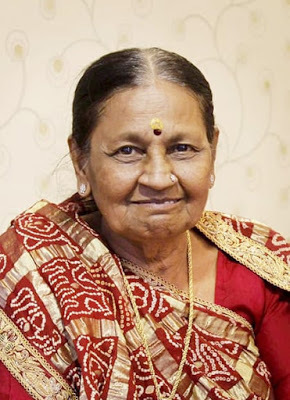
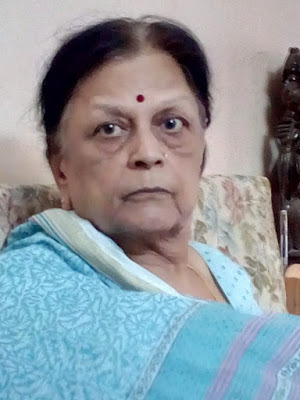
In the space of the last two months, two elderly Jain women, who passed away, insisted that their bodies be donated for research and organ transplantation
Photos: Bharti Maisheri and Jaswanti Ramesh
By Shevlin Sebastian
Homemaker Anju Bakul Shah looked through the window of her house in Mattancherry. On the opposite side live the Maisheris. But Bharti Maisheri did something unusual. She lay down on the sofa. It was the time of the evening prayers: 6.30 p.m. on June 6. Anju wondered, ‘Why is Bharti lying down now? She has never done this before.’
Since the mesh door was open, she quickly went across. Bharti was lying with her eyes closed. She tried to awaken the 71-year-old but there was no response. There was nobody in the house. Bharti’s husband Raichand was outside. Quickly, she called Bharti’s daughter, Sheetal Khona who lives less than a kilometre away. She came rushing.
Anju immediately began to say the powerful Jain prayer ‘Uvasaggaharam Stotra’: ‘I bow to Lord Parshwanath, who is affected by the distress of removing the Parshwa deity, who is free from all types of karma, who is the destroyer of the poisonous defilements and who is the abode of bliss and well being.’
Sheetal arrived. An ambulance was called. As they waited, the prayers continued. There was a tiny movement. Bharti, whose arms were lying at the side, suddenly clasped her hands together in prayer. “That was when I realised that her subconscious was alert,” she says. “I felt so happy that she was responding to our prayers.”
But Sheetal’s joy soon turned to sorrow when at the hospital her mother passed away quickly because of heart failure. And that was when Sheetal told community members that Bharti had specific plans. “She wanted her eyes to be donated,” she says. In a little over an hour, a team of doctors arrived from the Little Flower Hospital at Angamaly and took it away.
Bharti also wanted to donate her body to the Amrita Institute. Some conservative members tried to change Sheetal’s mind by saying that the community has specific rituals following a death. But Sheetal, as well as Raichand, remained firm.
“Today, at least seven people should have gained,” says Sheetal. “Two people will receive the eyes. Two the kidneys. One each will get the liver, heart and gall-bladder. The skin can also be used. The students will be able to study the anatomy. This will enable them to become better doctors.”
After 48 hours, the body would be cremated. “I feel a lot of peace and contentment that I was able to fulfill my mother’s wish,” says Sheetal. “Why destroy such vital body parts when it can make such a big difference in people’s lives. I think body donation should become widespread.”
In fact, Raichand, Sheetal and her husband Kamlesh will be donating their bodies when the time comes. Asked how they got the idea, Sheetal says, “My grandfather had only one eye but he asked that it be donated following his death. I had an uncle who donated his body 15 years ago.”
And what stiffened Bharti’s desire was when community member Jaswanti Ramesh, 74 died on May 1, and her body was donated to the Amrita Institute. “Sheetal called me and asked me all the details of how it was done,” says Jaswanti’s businessman-son Dharmesh Nagda. “I gave her the information and passed the mobile number of doctors at the Amrita Institute.”
Asked how his mother got the idea, Dharmesh says, “Two years ago, there was an awareness programme of body donation. My father Ramesh Bhai was much influenced and decided that when he died he would donate his body. My mother also agreed and they both registered their names at the Amrita Institute. That was how it happened.”
And Dharmesh, who is in the prime of life, says that he might also donate his body when he passes away. “I have not made a final decision as yet,” he says. “But I think it is a noble thing to do. Many community members asked me for more details about how it is done. I think this is an idea whose time has come.”
(The New Indian Express, Kochi)
Published on July 03, 2019 22:46
Casting a timeless spell
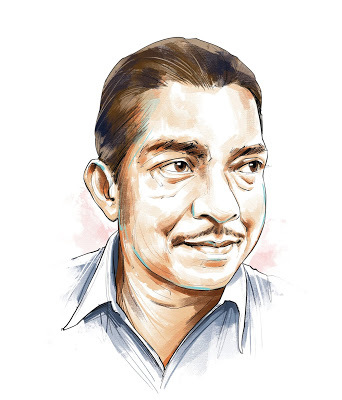
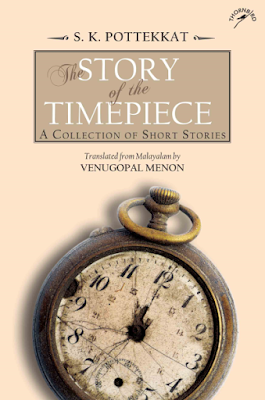
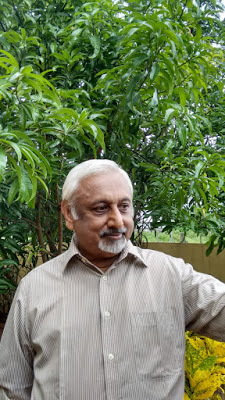
Translator Venugopal Menon talks about SK Pottekkat’s ‘The story of the timepiece’, which has just been published in English
Pics: SK Pottekkat. Illustration by Tapas Ranjan. The book cover; Venugopal Menon By Shevlin Sebastian
In 2014, retired engineer Venugopal Menon was travelling from Pune to Thrissur on a train. At Kannur, two youths got in. They took a seat next to Venugopal. Soon, the duo started discussing books. As a bibliophile, Venugopal could not help but listen in.
While one mentioned that his favourite authors are Madhavi Kutty, Paulo Coelho and Amish Tripathi, the other youth said, “There is no one like SK Pottekkat. I will prostrate myself before this gentleman.”
Venugopal was intrigued. At Kozhikode, their destination, they stepped out. At this moment, a bookseller entered the train. Venugopal asked him whether he had any books by Pottekkat. He had one: ‘Oru Theruvinte Katha’ (The Story of a Street). “I bought it and started reading it at once,” says Venugopal. “And I liked it very much.”
Little did Venugopal realise that within a few years, his friend, veteran editor Mini Krishnan would give him the commission to translate Pottekkat’s short stories into English.
And the book, ‘The Story of The Timepiece’ (A collection of short stories) has just been published by Niyogi Books, in an elegant edition, priced at Rs 395.
And when you read the stories, you realise that Pottekkatt has a God-given gift to cast a spell. The moment you start reading a story, you have no option but to read till the end. The writing is simple, clear, and accessible.
Or as Venugopal says, “A boy in Class 10 will like his stories and so can a 90-year-old man. Anybody can identify with the characters. Secondly, there is always some kind of intrigue. And thirdly, there is a sense of pathos. People are attracted to that because, at the core of life, there is pathos.”
For most readers, including Venugopal, the classic story is one about a character called ‘Ottakam’, a cart-puller of simple intelligence who is taken for the ride of his life by a cunning hotel owner. And pays the ultimate price. “It takes some time to understand the ending,” says Venugopal. “And then it is as if a light bulb has been switched on all of a sudden.”
The other story which Venugopal considers as one of his favourites is set in Nigeria and is called ‘Quahe-Ri’ (this is Nigerian for goodbye). An Englishman Seles falls in love with a native woman called Kabeena. A scion of a wealthy family, he leaves, but then realises he actually loves Kabeena. So, he returns, marries her and settles down to live among the blacks. Much later, he was shot dead by members of the white community, who were angered by what he did.
The English translation is a very competent one. And Venugopal has followed some simple tips given by Mini. “She told me the text should be simple and to the point,” says Venugopal. “It is important to omit unnecessary words and avoid long sentences. Make the words breathe.”
Venugopal took eight months to finish the book. And, he says, translating has had a good impact on him. “It is a very creative activity,” says Venugopal, who stays in Irinjalakuda. “You are putting your brain to work. Every sentence you write has to be thought over. That itself is therapeutic. If you are down and out, do some translations and you will feel on top of the world.”
As for Pottekkatt he was a prolific writer. He had an oeuvre of 60 books, which included a book about personal reminiscences, three poetry anthologies, four plays, 10 novels, 18 travelogues and 24 collections of short stories
But his forte was in travel writing. He travelled to many countries in Africa and Europe, as well as Sri Lanka, Indonesia, Singapore and Malaysia, and wrote entrancing pieces about his many experiences. “He was a very sharp observer,” says Venugopal. “And initially he made his mark as a travel writer.”
But today, he is among the pantheon of the greats of Malayalam literature and won many awards. These include the Kerala Sahitya Akademi Award, the Kendra Sahitya Akademi Award and the acme, the Jnanpith Award in 1980. His works have been translated into many Indian languages, as well as English, Italian, German, Czech and Russian.
Married to homemaker Jayavalli, he had two sons and two daughters. For one term, (1962-67), he was the CPM Member of Parliament from Thalassery. He died of a paralytic stroke, on August 6, 1982, at the age of 69 in Kozhikode. By then he was famous and widely respected as a writer. “I remember [Jnanpith Award winner] MT Vasudevan Nair saying that the style of Pottekkat was worth emulating,” says Venugopal.
(Published in The New Indian Express, Kochi, Thiruvananthapuram, and Kozhikode)
Published on July 03, 2019 05:06
June 30, 2019
Her own little patch of green
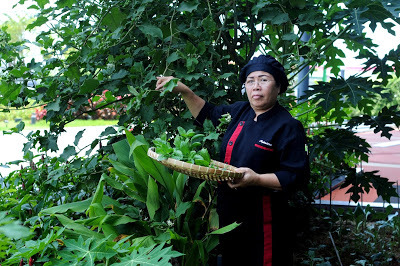

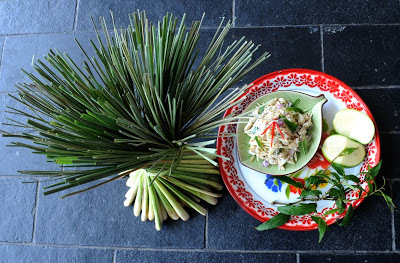
Supattra Boonsrang, Chef de Cuisine of the Thai Soul restaurant at the Grand Hyatt Bolgatty at Kochi talks about her herb garden which she has set up on her own. This enables her to provide pesticide-free produce for her guests
Photos by A Sanesh
By Shevlin Sebastian
An evening breeze is blowing. There are shouts of children as they frolic in the azure swimming pool of the Grand Hyatt Bolgatty at Kochi. A melodious song is playing over the sound system. People sit on low-slung chairs chatting and sipping glasses of juice. But oblivious to all this is Supattra Boonsrang, Chef de Cuisine of the Thai Soul restaurant.
She is standing in a black outfit, with a black chef’s cap, holding a bamboo tray, and snipping leaves with a pair of scissors. This is her herb garden which she had set up one-and-a-half-years ago, just outside the poolside restaurant. In it, she has been growing lemongrass, basil, ginger, galangal, eggplant, papaya, and butter peas.
Asked how she got the idea, Supattra says, “I realised that the climate in Kochi is similar to that in Thailand. There is a hot summer, a rainy season, a not-very-cold winter and high humidity. I used to have a garden in my home country.”
Not surprisingly, it is pesticide-free. In its place, she uses an unusual type of manure. “We put chicken and fish bones in the oven,” says Supattra. “Then we roast it. After that, we put it in the grinder and make a powder. This is good for the soil.”
Helped by two young employees, Supattra removes overgrown grass and leaves.
Soon, she takes a batch of lemongrass, laksa leaves and basil and heads into the kitchen….
She is making a crab meat salad. The meat is put in a charcoal oven and has been smoked. Supattra puts the meat, now cut into small pieces, into a bowl, and adds lemongrass, laksa leaves (Vietnamese mint), coriander, shallots, chillies and fish sauce, along with thinly-diced mango and mixes it up.
Soon, in quick succession, Supattra makes the Tom Yum Koong, a spicy prawn soup with kaffir lime, lemongrass and galangal (forest ginger), and a green curry called Kaeng Khiao Wan Gai, which has coconut, eggplant, and green chillies. This is to be eaten along with the long-grained Jasmine rice. This rice is available only in Thailand and has been imported.
As for the dessert, Supattra has made the Tab Tim Kromb. This consists of water chestnuts, in a red food colouring, dipped in coconut milk and crushed ice. To give a Kerala touch, she has put a slice of jackfruit on top. This is a cool concoction to have on a hot day. In fact, all the dishes have an intensity about it, and you cannot help but concentrate when having it.
When she is told this, Supattra smiles and says, “I use traditional methods. So, while most people these days chop vegetables, meat and fish by machine, I do it by hand. I still use the mortar and pestle. I feel that is the only way to give the food a human touch.”
This is her 25th year in the Hyatt International group. Earlier, she had served in Bangkok, Taipei, Jordan, Sharm-el-Sheikh (Egypt), and the Park Hyatt Dubai (for 13 years).
Her journey towards cooking began when she was growing up in the town of Yasoton in northern Thailand. Her father Payad used to work in a small restaurant as a chef. Supattra would help him in cutting and cleaning vegetables. “From a young age, I felt a great passion for cooking,” she says.
She began her career cutting vegetables in a hotel for one year. Then she washed them for another year. And from this low-key start, she is now one of the most enduring talents of the Hyatt group.
Asked about the changing trends she has observed over the decades, Supattra says, “People want food that can be made fast. Time is short for everybody. They prefer less garnish. Earlier, when you went out for dinner, there were many courses that were served. Now all the dishes have to be put out at once. But I am also happy to note that Thai food has gained a worldwide reputation. One reason is that it is steamed, so it is very healthy and light on the stomach. My own mother, at 88, is so fit she walks faster than me.”
As for her aim today, she says, “I want to make Thai food popular among Malayalis.”
Published on June 30, 2019 22:31
June 25, 2019
Always under attack but never giving up
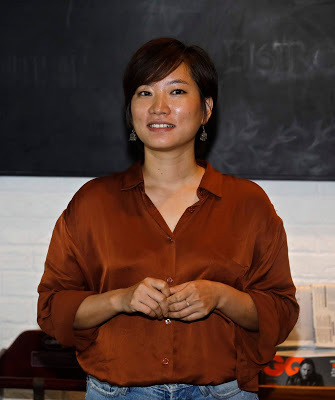
On a recent visit to Kochi, social activist Ngurang Reena, from Arunachal Pradesh, talks about the discrimination and harassment faced by the people of the North-East in cities like Delhi and Mumbai
Photo by Arun Angela
By Shevlin Sebastian
It was a winter’s day at Chandni Chowk, New Delhi in 2009. At 3 p.m., Ngurang Reena got onto a hand-pulled rickshaw. She was swaddled in warm clothes. As the rickshaw moved forward, it got caught in a traffic jam. Six men approached the rickshaw. Then with a sense of impunity, they began to molest her. Reena felt shocked. “I was so young I could not understand what was happening,” she says.
Despite that, Reena retaliated. She hit one man but another grabbed her hand and said, “What can you do?” Says Reena, “I felt completely alone. Everybody was just watching. And nobody said anything.”
Reena rushed back to the hostel. She felt violated. She cried. And then she decided she would return to her village in Arunachal Pradesh. But when she called her father, Ngurang Pinch, a former MLA, he said, “If you leave now, you will run away for the rest of your life. You have to understand what's happening, and then face it.”
Reena listened to her father and stayed behind. “It was the right decision,” she says.
Reena looks sombre at a restaurant in Kochi on a recent afternoon. She had been invited by the NGO Raising Our Voices Foundation to give a talk about life in the North-East.
A former Assistant Professor of Political Science and International Relations at Delhi University, she says, “I don't think there is a single girl from the North-East who has not had a bad experience in Delhi. Whenever one of us walks down a street in the evening, somebody or the other will come up and grab our breasts or ass.”
And the experiences at the police station are morale-shattering. “The first question is usually, ‘Why were you walking alone?’ followed by ‘What were you wearing?’” says Reena. “So, it all comes down to moral policing. There is no agency for us to take the complaint forward.”
There is a stereotyping of the girls from the North-East that has remained consistent over the years. “Because we choose to dress differently or have coloured hair, there is a perception that we are loose characters who sleep around with everybody,” she says. “When we go to social gatherings or a party men just pounce on us. We face this often.”
The discrimination continues in other areas. When the girls look for apartments to rent, the landlord will look at them and say, “Are you sure you will be able to pay the rent? I hope you will not indulge in drinking, drug-taking, sexual activities, or prostitution.”
In Kochi, Reena had a different experience. While in a cab, the driver got curious on seeing her. “He was so excited to learn that I am from Arunachal,” says Reena. “He asked me whether Arunachal was part of China. And I had to tell him, it was part of India.”
This confusion continues when Reena goes abroad. She went to Germany and every day people asked her whether she was Chinese or Japanese. They refused to believe her when she said she is from India. “In fact, they told me I was lying,” says Reena.
So, she is in a perennial state of limbo; of not belonging anywhere. And back in Arunachal Pradesh, where she should feel at home, she has stirred a hornet's nest by launching a campaign against polygamy and other social evils with her sister Meena through their NGO The Ngurang Learning Institute. “People think that women are free in Arunachal,” says Reena. “But that is not the case. Most of the time, in our Nyishi tribe, they are the second or third wives of a man and have no status whatsoever.”
Of course, it is not legal. But the 200 tribes in the state have different traditions. “And in the case of polygamy, the state does not interfere, because it is a ‘tribal custom’,” says Reena.
But some men are angry at her activism. One man, whose wife is a student at the institute, came armed with a dao (the local machete) and told Meena, “Stop teaching my wife. She is 40 years old. Is this the time to study? She is better where she belongs, in the kitchen.”
But thanks to the affirmative nature of the Indian Constitution, and her father’s support Reena was able to escape this fate. She got a good education and eventually began working in Miranda House, one of New Delhi’s elite colleges. “You have to understand from where I come from,” says Reena, who is at present a PhD research scholar in the School of International Studies at Jawaharlal Nehru University, New Delhi. “My mother never went to school, and my father failed in Class 10. I am one of the first from our family to enjoy a higher education.”
And despite the many upheavals in her life, including the murder of her father in 2017, for which she battled and failed to get a CBI probe, Reena, says, “I continue to move forward. Hard knocks only make you stronger.”
(The New Indian Express, Kochi, Thiruvananthapuram and Kozhikode)
Published on June 25, 2019 23:02
June 24, 2019
"Yogi-San, we are going to vote for you”
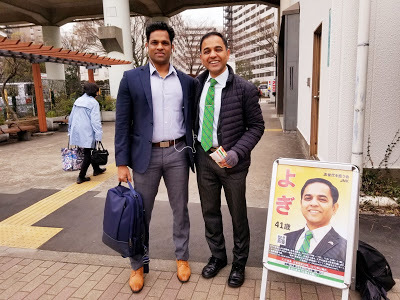
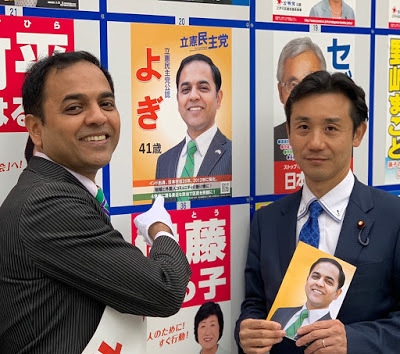
The Pune-born Yogendra Puranik became the first Indian to win electoral office in Japan. He talks about his experiences
By Shevlin Sebastian
Through the corner of his eye, Yogendra (nickname: Yogi) Puranik notices a man in a wheelchair, who is hovering near the edge of the crowd in the area of Kasai in Tokyo. Yogi is campaigning to win a seat as a councillor in the Edogawa Ward assembly. The 35-year-old man stands up, and with the help of people next to him, manages to come near Yogi.
Then he says, “Yogi San, what are you going to do for the handicapped people?”For a few moments, Yogi is flummoxed. He is a dynamic-looking 41-year-old, with an easy smile, wearing a black pinstripe suit, a green tie and shiny black shoes. On his lapel, Yogi had pinned two tiny flags next to each other: that of Japan and India. He also has a white sash across his chest which displays one word, in red Japanese letters, ‘Yogi’.
The candidate shakes his head and said, “Honestly speaking, I don't have a separate agenda for the physically-challenged people,” he says. “But if I am elected, I want to do something for everybody. So that will include the physically-challenged.”
The man says, “Yogi San, I like the way you acknowledged that you have not written about our concerns in your election manifesto. I believe you are a person I can trust. So I am going to vote for you.”
Yogi smiles and says simply, “Thank you.”
Wherever he goes, be it in parks, outside metro stations, office buildings or malls many people shake his hand and say, “We are going to vote for you.”
And they did. Because when the election results were announced on April 23, Yogi became the first Indian to win electoral office in Japan.
It was the culmination of a long journey. It began after he completed his Class 12 studies, and his father suggested that, apart from studying physics and IT, Yogi should study a foreign language. “My father told me Japanese could be a good option,” says Yogi. So, in July, 1994, he began a three-year degree course from the University of Pune, where the Puraniks lived.
He liked the language and was able to complete the course. In September, 1999, he got a scholarship for a one-year course. “We were given housing, and lived in a cosy environment,” says Yogi. “Everything was well taken care of.”
Following his return, he started working for an IT company in Pune. Then, in March, 2001, he got a job in an IBM company and returned to Japan. But this time he did not enjoy his stay. “I found the society to be very hard,” he says. “The Japanese are, on the surface, very receptive and polite, but actually, they keep a distance from you. Even among the Japanese, they keep a distance from each other. So when it came to a Japanese and a non-Japanese, the gap is quite large. So, I started feeling very lonely.”
He resigned after eight months and returned to Pune. But fate had other plans in store. When he joined Infosys in 2003, they sent him back to Japan once again. But this time, Yogi was determined to do something about his isolation.
He started participating in community gatherings, meetings, and the Parent Teacher Association in Nishi-Kasai, the area where he lived, in Tokyo. “I went to local festivals, not just to attend, but to participate, enjoy the food and help out in the preparations,” he says.
The Japanese got very excited. In the next year, he was appointed as the director of the festival. They told him, “Yogi San, you should be our bridge with the foreigners living in our society.”
And Yogi did become an effective bridge. He also became very popular. But his turning point came during the massive earthquake which hit Japan on March 11, 2011, followed by the tsunami. He, along with a couple of friends, set up a helpline for the Indian community. They received more than 300 calls daily. Apart from that, with Japanese friends, he went into hundreds of local homes and provided a helping hand. “That was when I became close to the Japanese,” he says. “I felt I belonged.” So, in October, 2011, Yogi applied for citizenship and got his papers a year later.
On the personal front, he was briefly married to a Chinese woman, Zhe Zhang, whom he had met at the University of Japan. The marriage did not work out, but they had a son Chinmay whom Yogi brought up on his own. He is studying in Class 12 in Britain.
“Zhe lives in China,” says Yogi. “My son visits her regularly.”
Asked about his future plans, Yogi says, “I want to become an MP one day. I also want to change Japanese society by making people show more emotion and attachment to each other, just like the Indian way. ”
Published on June 24, 2019 05:26
June 18, 2019
Starting from scratch
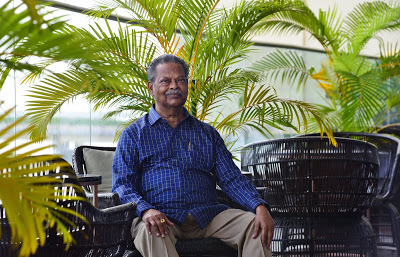
John Geevargese is the leading Malayali entrepreneur in Gujarat. He talks about his success story as his autobiography in Malayalam is released at a function in Kochi
Photo by Albin Mathew
By Shevlin Sebastian
John Geevargese stared at the TV screen in utter shock on the morning of June 23, 1980. The cameras were panning on the broken parts of the Pitts S-2A plane which had crash-landed around 500 yards from Willingdon Crescent, the official residence of Congress leader Sanjay Gandhi in New Delhi. It had been flown by Sanjay, who was a passionate flyer. While doing an acrobatic turn, he lost control. The crash killed Sanjay instantly He was only 33.
A few weeks earlier, the Ahmedabad-based entrepreneur had met Sanjay through Defence Minister V K Krishna Menon. This was regarding the Maruti car project which Sanjay had started. John wanted to become a dealer for the whole of Gujarat. Sanjay accepted John’s request and the latter gave a security deposit of Rs 3 lakh.
But Sanjay’s death put the project into uncertainty. John wondered what to do. He already had put up a showroom, with an area of 16,000 sq. ft. on Ashram Road. “That’s when I decided to go into the retail business and set up the ‘Sales India’ shop,” says John, while on a recent visit to Kochi where his autobiography in Malayalam, ‘Eithihaasika Jeevitham’ was released.
It was an outlet in the right place at the right time. India was moving from a socialist to a consumer economy. John started selling refrigerators, air conditioners and small appliances. To improve the customers’ experience, John laid out everything in a stylish manner.
Soon, ‘Sales India’ made a name for itself. “If a customer experienced any problem with an appliance, I would get it replaced,” says John.
This created a good impact with customers. Now John has 33 outlets across the state. Then John’s life took a different direction. One day in 1991, the leading members of the Association of South Indians in Ahmedabad (Asia) approached John and told him that the school they were running was in financial difficulties. “They said they were not in a position to pay the salaries of the teachers,” he says. “Initially I was not very keen but in the end, I took over the management.”
Soon, John put all his efforts to make the Asia school a success. Then he started another one. Now there are five schools. Then he ventured into colleges and set up the JG (his initials) International School. Now there are 25 colleges all over the state. In total, there are 12,500 students, of which 4700 are in the schools.
The schools are run almost in a philanthropic way. The children of any South Indian, with an annual income of less than Rs 5 lakh can study free of cost at any of the Asia schools, under the CBSE syllabus, from nursery to Class 12. The cost of the uniforms, books and travel are paid for. John also set up a Performing Arts College, which offers Bachelor's and Master's degrees in classical dance, drama and music.
John’s most recent achievement was to set up a YMCA International Centre, in an area of 4 lakh sq. ft. Some of Bollywood’s leading singers like Sonu Nigam, Hariharan, Alka Yagnik and Udit Narayan have performed there.
Sometimes, on peaceful Sunday afternoons at his bungalow on Ashram Road, John goes back into the past. He grew up in idyllic Enathu, which is in Pathanamthitta district. As a child, he would take a herd of buffaloes to the Kallada river so that they could frolic in the water. He would lie on the grassy bank, and stare at the sky. And every morning, he would go barefoot to school, which was 14 kms away. His father Geevargese Chona ran a small grocery shop cum tea stall. “Thanks to my father, business is in my blood,” he says.
When he passed out of Fatima College in Kollam with a B.Com degree, he decided to go outside the state to improve his prospects. In 1958, he went to Chennai and from there to Mumbai where he secured a job at the Secretariat as a Lower Division Clerk. At that time Mumbai consisted of Gujarat and Maharashtra. But in 1960, Mumbai was divided into two states. “Being a non-Maharashtrian, I was sent to Gujarat,” says John. “That was how I reached Ahmedabad.” But within seven years, John resigned and became a businessman.
Asked to describe the people of Gujarat, he says, “The Gujaratis are very lovable and trustworthy. They will not cheat you. They will not indulge in any quarrels. They believe in making money and they want everybody who comes to Gujarat to become rich. They are not jealous.”
John is married to homemaker Chandramati, and has three children, Jose, Joy and Sunita. Asked the secret of success, the 82-year-old says, “You should have a clear vision. And always say to yourself, ‘I will make it’ and it will happen.”
And it has. Says MP Chandran, Trustee and Executive Director of the Asia Charitable Trust, “John Sir has worked for 60 years, 15 hours a day, sacrificing time with family and giving up his personal satisfaction to build a fortune. But he used it to help others. And he told me he has no regrets.”
(The New Indian Express, Kochi, Thiruvananthapuram and Kozhikode)
Published on June 18, 2019 23:11
June 17, 2019
Getting high….non-stop
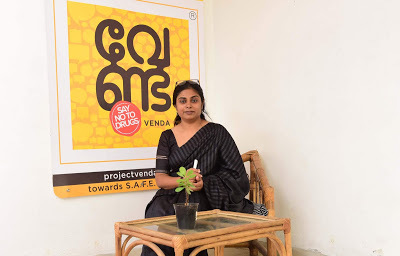
Diana Joseph, the founder of the Kochi-based NGO ‘Venda’ (Say No To Drugs) talks about how drug-taking has become an epidemic among the youth in Kerala
Photos by Albin Mathew
By Shevlin Sebastian
“Amma, I am going cycling,” says Luke, on a Saturday afternoon at his home in Fort Kochi. Since this has become a weekly habit for a few weeks, Luke’s mother Reena says, “Okay.” The fifteen-year-old takes his bicycle out on the road and starts pedalling.
After 10 minutes, Luke reaches the beach and meets up with his classmates, all of whom are students at a nearby government school. Soon, Mahesh Uncle, an elderly person of their community arrives on a bicycle. All the students do ‘high fives’ with him before they set out.
They ride down many roads. All of them love cycling. And after an hour or so, they enter Container Road, which is near the International Container Transshipment Terminal at Vallarpadom. There are many trucks parked on one side. Mahesh introduces the boys to the drivers, many of whom are from North India. Soon, the boys are given treats, followed by alcohol and drugs. Hours pass. The boys are also shown pornographic films on mobiles. They are feeling dazed by what they are seeing and taking. Later, as it gets dark, the drivers sodomise the youngsters. Each time, it happens, Luke feels disturbed.
Finally, he tells the physical trainer in the school, who calls the Kochi-based NGO ‘Venda’ (Say No To Drugs). ‘Venda’ is part of the Bangalore-based ‘Fourth Wave Foundation’, which works for education, empowerment, ethics and inclusion. In Kochi, they started focusing on drug counselling because of widespread addiction.
“Luke and his friends went through rigorous counselling over a period of months before they returned to normal,” says Diana Joseph, the founder-director of ‘Venda’. “Today, they are concentrating on their studies but, at the same time, they are being monitored.” And what made Diana especially happy was the quick reaction of the police and the Narcotics Control Bureau, when they were informed about what was happening. “They began regular patrolling,” says Diana. “Now, the road has become safe.”
But the news otherwise is gloomy. On May 30, at a function, at Kochi, Kerala State Excise Commissioner Rishiraj Singh said, “The second highest drug abuse cases in India has been reported from Kochi.” (Amritsar has the highest).
The drug users are as young as nine years old. They include boys and girls. Most of them stay in high-risk areas where drug-taking is rampant. “As a result, children will end up being mules (drug carriers), or they will use it or get affected by it. Maybe, somebody in the family is already an addict.” As for the drugs which are consumed, they include heroin, marijuana, hashish, crack and cocaine.
Asked how they get access to it, Diana says, “You can buy it online if you can get access to certain shadowy groups on Facebook and Whatsapp. Many small shops, like bakery outlets and photocopy shops, near schools sell it. Apart from them, it seems like organised crime is pushing these drugs in towns and cities all over Kerala.”
Not surprisingly, many teenagers from financially straitened families are lured to become mules. “I want to be rich,” says Deepak, 17. “Only donkeys sit in classrooms for twenty years to earn a small salary every month. That’s why I became a mule. It’s good money. If there is a big haul, I can earn Rs 1 lakh or more from one delivery.”
As for the reasons for youngsters taking to drugs, Diana says, “Peer pressure. Exam stress. Broken families. Emotional problems. Failed affairs.”
So ‘Venda’ has embarked on a ‘prevention is better than a cure’ programme. So they go to schools and colleges and conduct programmes about the dangers of drugs, of how lives can get ruined if you get addicted. “Awareness makes a difference,” says Diana. “We also do counselling for parents as well as teachers. Many of them are in a state of denial. They find it difficult to accept that their child or student is taking drugs.”
Last year the NGO dealt with 221 cases. “Out of that 62% came out of the addiction,” says Diana. “Another 10% are out of it but need long-term help. About 28% need continued counselling.”
All this hard work has resulted in some good news for ‘Venda’. Diana was invited to present ‘Venda’s’ work at the 61st Congressional on Narcotics and Drugs at the United Nations in November last year. ‘Venda’ was also featured as a ‘Best Practice Case’ in the guide for civil societies at the Ministerial Segment of the United Nations Office on Drugs and Crime in March this year. “We are happy to make a difference, however small it may be,” says Diana.
(Some names have been changed)
Published on June 17, 2019 23:14
June 16, 2019
Local, natural and delicious
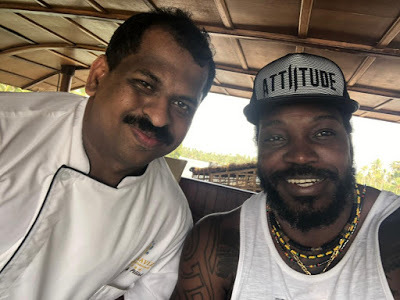
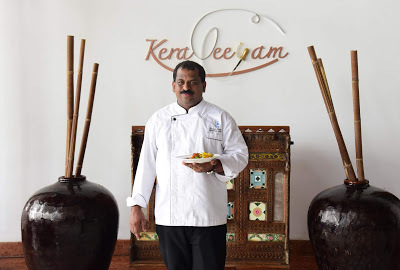
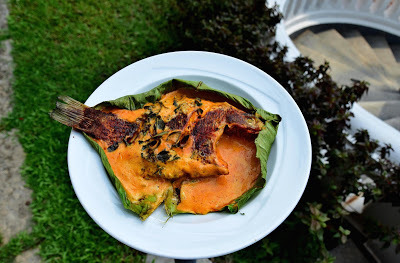
Corporate Chef Suresh Pillai of the Raviz Resort and Spa, on the banks of the Ashtamudi Lake, Kollam, has made a unique menu based on the fishes in the lake
Pics: Chef Suresh Pillai with Chris Gayle; Chef Suresh Pillai; the Pearlspot Pollichathu (fried)
By Shevlin Sebastian
The cap has the word, ‘Attitude’ written on the front. The white sleeveless banian compliments the black Bermuda shorts. There are tattoos all over the arms and upper shoulders, and golden necklaces around his neck. West Indian star cricketer Chris Gayle looks relaxed and breaks out into an easy smile as he sits at the floating restaurant, ‘Randaal’, of the Raviz Resort and Spa, on the banks of the Ashtamudi Lake, at Kollam (138 km from Kochi).
Chris is accompanied by his girlfriend Natasha Berridge and two-year-old daughter Crisalina. Corporate chef Suresh Pillai places a sizzling pearlspot fish on a green leaf in front of the cricketer. Chris takes a fork and digs into the fish. After a while, he looks up and says, “It’s good, man.”
Suresh beams and provides a seafood meal: prawn, oysters, crab and snapper.
Later Suresh says, “We always use fresh ingredients. The pearlspot has its own flavour. In Kerala cuisine, there is a tendency to use a lot of masala powder. As a result, it overcomes the flavour of the fish. So, for the pearlspot, I used the first extract of the coconut milk, black pepper, ginger and curry leaves. I did not put any masala, but a dash of turmeric.” Incidentally, after Chris’s visit, Suresh changed the name of the dish from Pearlspot Pollichathu (fried) to Pearlspot King Gayle.
Since the resort is next to the lake, Suresh has made a specific menu called the ‘Taste of Ashtamudi’. “Usually only the local people eat these fishes, but I wanted our guests also to enjoy it,” says Suresh, who worked in London for 14 years and was a participant in the BBC Masterchef programme in 2017.
“Earlier, there was a thinking that foreigners prefer large fish like kingfish, which has very little bones. But I have discovered they also like fishes with bones. Also, the lake fish have a distinct flavour.”
In Asthamudi, which has an area of 62 kms, there is a tributary called the Kanjirode. Earlier, there was a tapioca factory. The tapioca waste would be dumped into the lake. “The pearlspot loves this waste,” says Suresh. “As a result, the fish has more flavour and is regarded as one of the best.” It is also the most expensive. The usual pearlspot sells for Rs 400 per kilo, but the Kanjirode pearlspot sells for Rs 900 per kilo.
Another reason for the unique taste is because the mud has an earthy taste. In the olden times, the work on making coir products would take place by the side of lakes and rivers in Alleppey and Kollam districts. “The shell of the coconut would be soaked in the water for three months,” says Suresh. “And this is the cause for all sorts of flavours in the fishes.”
Apart from the pearlspot, the other items on the menu are the yellow clams, mussels, groupers, mullets, Indian bream, catfish and oysters. “In the West, people eat oysters raw, but in Kerala, we prefer to cook it,” says Suresh. “It could be stir or deep fried or roasted.”
Suresh also serves Tiger Prawns, as well as the mud crabs. The mud crabs are caught in a most unusual way. There is a long rope that has numerous hooks, which has feed on it. Then it is placed in the water. The crab starts feeding on it. The rope is gently pulled up. And the crabs are pulled away and put into a fishing net.
Usually, the fishermen go to catch fish every day at about 4 a.m. Suresh sometimes buys the catch from the local market or some fishermen come directly to the resort. Unfortunately, there is a negative aspect to this fishing.
Some fishermen use nets with small gaps. As a result, all the fish are caught including the baby fishes. “They should only catch the bigger fish and leave the small ones,” says Suresh. “But this is not being done. One snapper can feed six people. But if a baby snapper dies, it is gone forever. There is a lack of awareness among fishermen. They don’t know how to sustain the environment. So many species are becoming extinct. However, some know they are doing harm. But they say they are doing it for their livelihood.”
Suresh suggests that like in the seas, there should be a ban on fishing in the lake during particular months. “The government should also conduct awareness classes,” he says. “That is the only way to protect our fish wealth.”
Published on June 16, 2019 23:34
June 14, 2019
A long-ago photograph churns up emotions
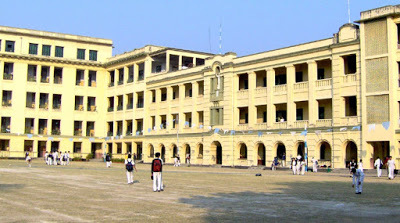
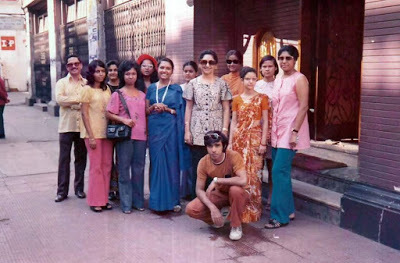
By Shevlin Sebastian
When my former classmate Ranjan Kamath put up a photo on Facebook, of a few of our teachers, at St. Xavier’s Collegiate School in Kolkata, emotions welled up inside me like an ocean wave. It is a picture taken of them as a group, in 1976, on an early morning, at Park Street, outside the famed Mocambo restaurant.
The angled sunlight lights up the wall behind them, but all of them are in the shade. Among the women, who are in the majority, I can recognise Mrs. Fernandes, Mrs. Mustafi, Mrs Sodhi, Miss Gonsalves and Mrs Stephens. While one wears jeans, another is in black slacks, three are in brightly-coloured bell-bottoms, one in a skirt, while the rest are in sarees. But they are smiling and looking happy. And they are exactly as I remembered them, in their thirties and forties, radiating energy and confidence.
Right in front of the group, sitting on his haunches is the handsome Ronald Gass. His sunshades are resting on his wavy hair, and he wears a brown T-shirt and slacks, with long sideburns, a style statement of that time.
They are about to go for the annual teachers’ picnic on a bus. So, this is a pick-up point. They look ready to have fun in each other’s company.
So how did Ranjan get the photo? His mother Cecelia D’Souza was a teacher and this was in her collection. But she died of cancer two years ago. A heart-breaking blow for him. Others may have died, but I don’t know. One teacher, Rama Singh, lives in New York with her son Arvinder Pal.
They must all be in their seventies and eighties. Their youthful looks must have given way to wrinkles, creaking joints, and a slower pace of life. Has life treated them well? Are they okay financially? Do they have health problems? Are their children looking after them? Or are they now living in an old age home? I had no answers. But the photo confirmed what I knew subconsciously: their influence abides in me, as strong as ever.
When I look at the photo, I am also looking at my own passing years. The student in me is long dead, along with a bit of the innocence of that time. I could not help but think of time. How it never stops, but just goes on and on...relentlessly. As I keep staring at the photo, I have an unexpected reaction -- my throat tightens. It takes me a while to understand why. Just as we students and teachers are moving forward, from the opposite side, Lord Yama, the God of Death is moving towards us, on a horse, his mace held high, waiting to pluck us, one by one.
(Published as a middle in The New Indian Express, South Indian editions)
Published on June 14, 2019 23:54



